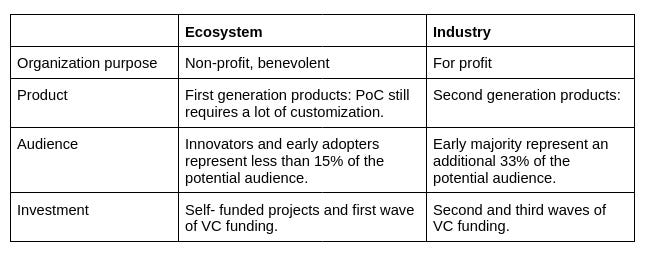Lightning Network: from ecosystem to industry
Part 1: An overview of the Lightning Network
This article is part of a more extended series wherein we explore the Lightning Network's evolution and propose an in-depth analysis of liquidity services. The research follows a top-down approach by providing an overview of the Lightning Network industry and focusing on specific lightning liquidity projects, products, or companies that have recently emerged.
The Lightning Network Industry
The Lightning Network has evolved from reckless to professional within a few years. From an ecosystem to industry, from a group of enthusiasts to communities and entire countries.
The Cambrian explosion of projects and companies crafted over the first years of its life is one of the most distinctive signs of nascent ecosystems. But what is an ecosystem?
Even if this definition is hard to give from an economic perspective, an ecosystem generally refers to a network of interdependent elements or organisms that work together to sustain a balanced system. In the context of the Lightning Network, an ecosystem would refer to a community of developers, users, and businesses that use the network to facilitate fast, low-cost, and private transactions on the Bitcoin network. This community is self-sustaining, with users and developers contributing to the network through node operation and code contributions.
On the other hand, an industry refers to groups of companies or organizations that produce goods or services within a specific market. In the case of the Lightning Network, as the technology matures and adoption increases, businesses and organizations have started to offer specialized products and services to provide even better experiences to their customers.
This specialization is one of the main driving forces to the emergence of the Lightning Network industry, where businesses' goal switches to service monetization and profit making.
As shown in the following table, ecosystems and industries differ at several levels of the value chain, from actors' profiles to value creation and funding:
Where should the Lightning Network go?
One of the first points we should address as a community is whether the evolution to an industry is even desirable. After all, everyone could keep using open-source tools and be happy. Not exactly.
The scenario of services and tools built by independent developers could be viable if Lightning Network limited itself to the community of bitcoiners and an anonymity/tech-savvy audience. In the past, we witnessed similar open-source tools whose adoption never managed to reach a broad audience:
PGP was also a brilliant invention with great potential for digital identity and online privacy applications. However, the user experience has never been improved sufficiently to allow an adoption beyond code signature and epic key signing parties.
Linux kernel was created to provide a free, open-source alternative to proprietary operating systems and has become a preferred solution for professional developers and servers. However, it occupies less than 3% of the desktop/laptop OS market share as of 2022 (15% for Mac OS and 70% for Windows).
We will all agree that the potential of the layer 2 technology is much larger than a few percents. The companies operating in the payment industry are here to remind us that competition and alternatives already exist. Payment service providers such as Visa, Mastercard, and American express already provide very reliable payments to their customers in most parts of the world. Reversing the network effects and breaching the barriers built over the last 60 years will be challenging if Lightning Network folks don´t channel their efforts.
We all want the Lightning Network to succeed and become one of the main - if not the main - payment networks. To make that vision come true, the industry should enter a virtuous circle in which builders design better products, leading to more users, VC investments, and more builders again, in that order. As the wheel spins, every actor focuses on providing specialized services that will increase the sophistication of the whole industry.
So going back to the first question, do we need Lightning Network to evolve from ecosystem to industry? Yes. It is not only desirable, it is essential. And we are getting there!
Key factors: How?
A combination of factors, including technical features, user experience, and overall market conditions, will likely drive mass adoption of the Lighthing Network.
Technical features, such as fast transaction times, low fees, security and reliability, will be key differentiators as users seek solutions that meet their needs for fast and affordable payments. As previously discussed in our article on observalibility, many efforts are still required at the network level to reach high throughput and reliability. Additionally, the ability of the Lightning Network to offer private transactions will attract new users.
User experience will also play a significant role in driving the adoption of the Lightning Network. If the network is easy to use and provides a seamless user experience, this will undoubtedly lead to increased adoption. The availability of user-friendly wallets and applications that make it easy for users to access and utilize the network will be primordial.
As we have seen many times, market conditions significantly increase awareness. NgU - Number goes Up - refers to the fact that Bitcoin, unlike the internet, is a tradable technology whose price depends on demand and supply. In a context of limited supply and growing adoption, the price is meant to go up, a.k.a. NgU. More people will hear about Bitcoin during the next bull market and seek solutions to meet their needs. By then, Lightning Network will have solidified even more.
Last, but not least, capital. Investment is a critical component of any digital industry's growth as it helps fund the ongoing development and improvement of the network, support its growth and reach, and ensure its competitiveness in the market. Lightning Network needs to attract more private money from angel investors and VCs and unleash its disruption power.
Perspectives
Within a bit more than 7 years, Lightning Network progressively transitioned from a concept to an ecosystem and a nascent industry. As shown on Lighthing Landscape, builders and enthusiasts have already delivered hundreds of projects and companies during the first years.
However, the risk of seeing technologies not crossing the chasm is real. It has already happened, and it will happen again.
The evolution of Lightning Network from an ecosystem to an even more structured industry is essential to reach mass adoption. Improving technical features and user experience will be helpful, especially if it coincides with a bull market. Also, the industry's future relies on more investment, which will fund its development and support its growth and competitiveness in the market.


